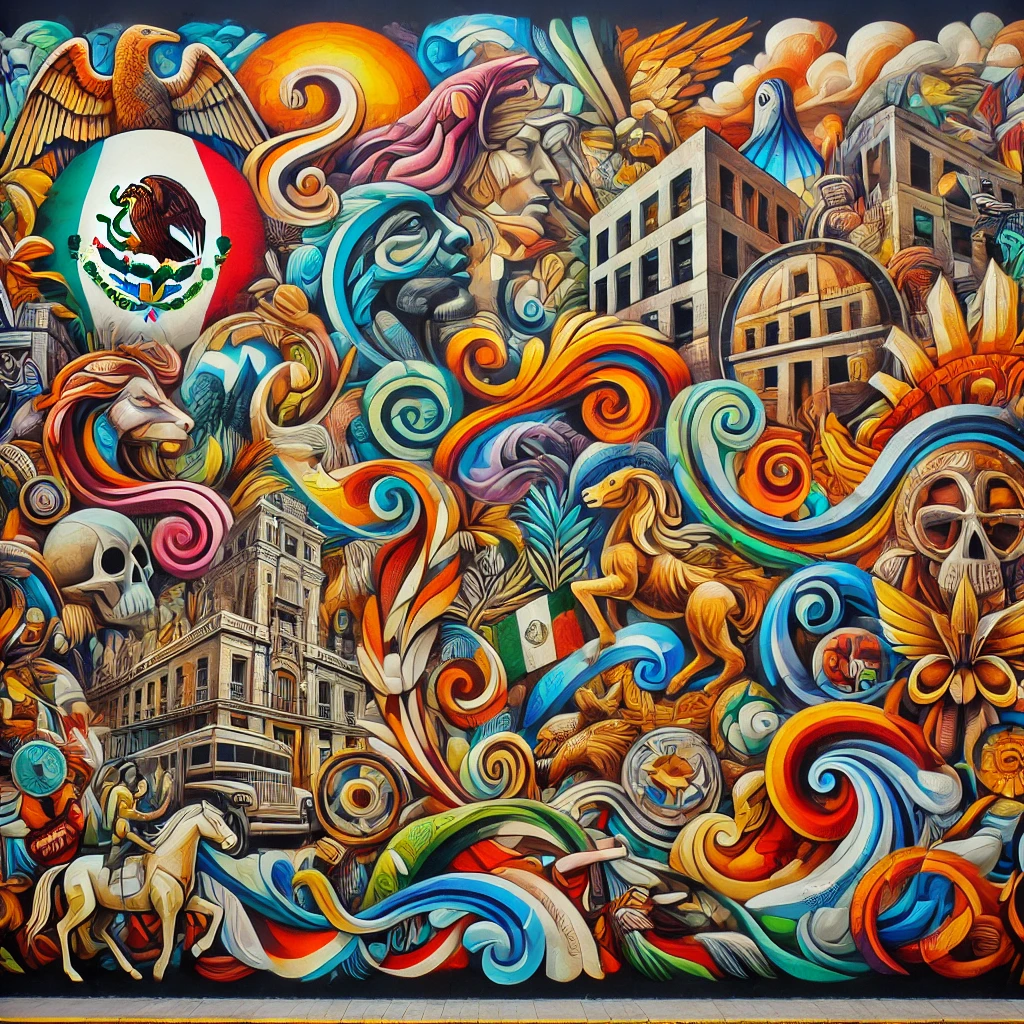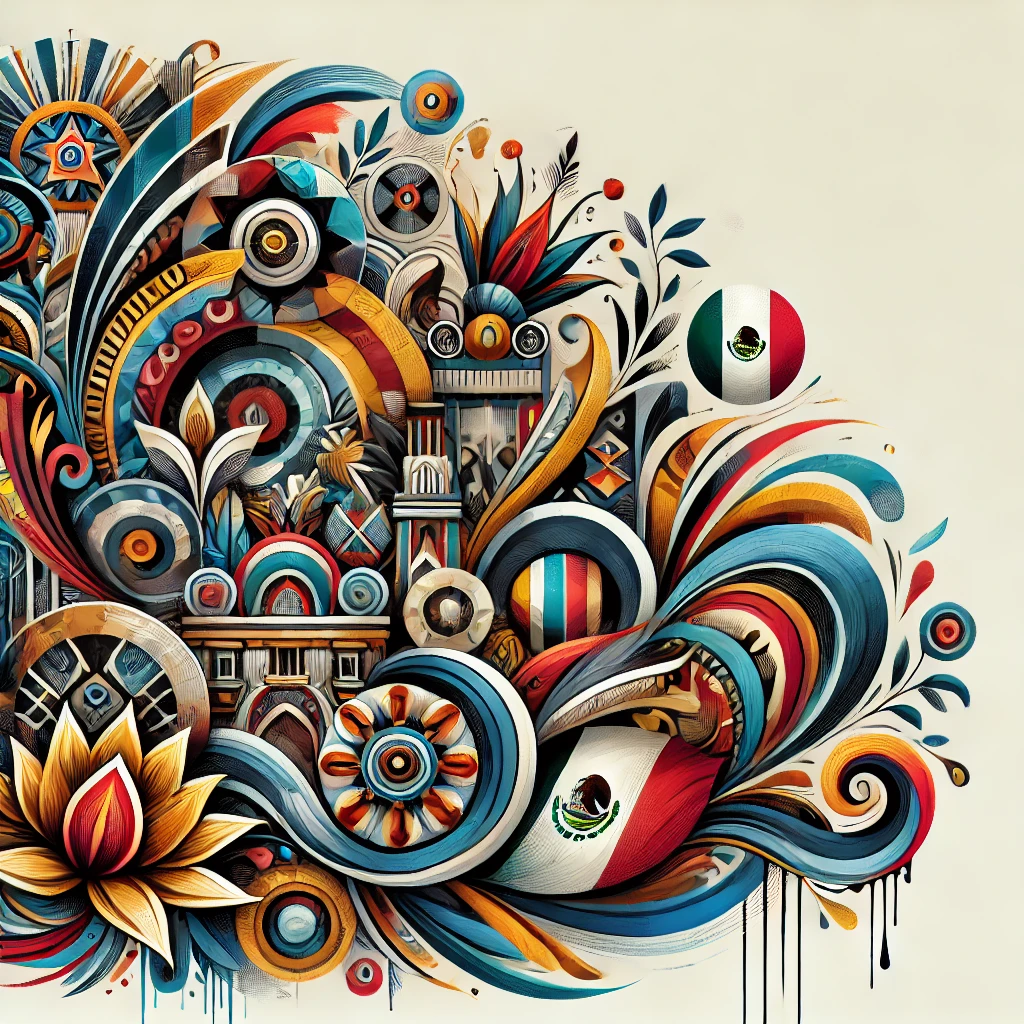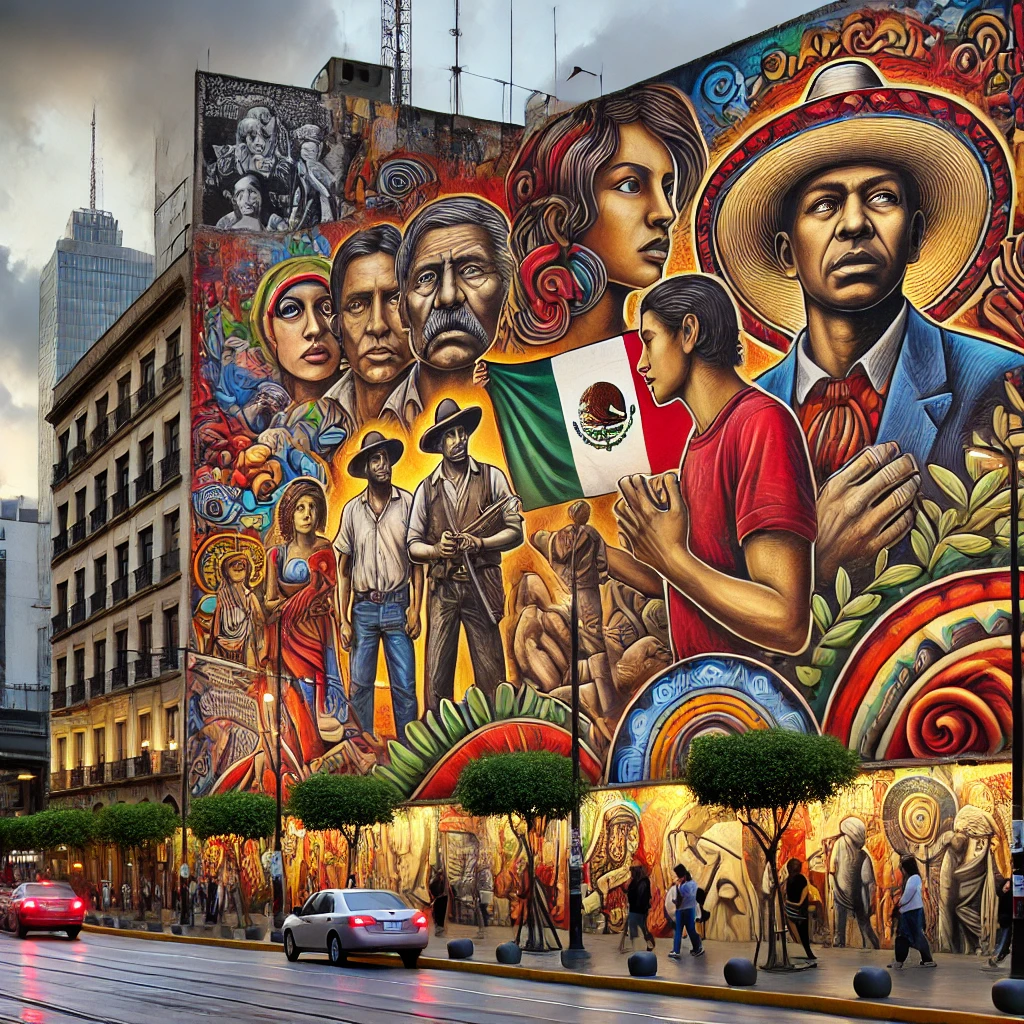Table of Contents
Introduction to Mexican Muralism
Mexican Muralism emerged as a significant artistic movement in the early 20th century, rooted in the complex historical and cultural landscape of Mexico. This transformative period followed the Mexican Revolution (1910-1920), which sought to address deep-seated social inequalities and promote a sense of national identity. Artists such as Diego Rivera, José Clemente Orozco, and David Alfaro Siqueiros were at the forefront of this movement, using large-scale murals as a means to convey socio-political messages and reflect the aspirations of the Mexican people.
The historical context that led to the rise of Mexican Muralism is essential in understanding its significance. Following the tumultuous revolution, a desire for unity and cultural rejuvenation permeated Mexican society. Artists and intellectuals sought to create a new visual language that would celebrate indigenous heritage while addressing contemporary social issues. The government played a pivotal role by commissioning murals in public spaces, aiming to educate the populace and instill a sense of pride in Mexico’s rich history.

Public art became a powerful tool for expressing collective identity in Mexico. The murals often depicted themes such as social justice, the struggles of the working class, and the celebration of Mexican culture. This focus on accessible art brought intricate narratives to the masses, allowing a broader audience to engage with visual storytelling. Through these murals, artists confronted the tensions between tradition and modernity, while fostering a renewed sense of hope and purpose in the post-revolutionary nation.
The impact of Mexican Muralism transcended national borders, resonating with artists and activists worldwide. This movement not only transformed the artistic landscape of Mexico but also inspired similar approaches to public art in various global contexts. As we delve deeper into the themes and individual contributions of key figures in this movement, we begin to appreciate the lasting legacy of Mexican Muralism in shaping public discourse and artistic expression.
The Origins of Muralism: Historical Context
The emergence of Mexican Muralism in the early 20th century was deeply rooted in the historical context surrounding the Mexican Revolution, which began in 1910. This tumultuous period marked a significant shift in the political and social landscape of Mexico, as citizens sought to dismantle oppressive systems and envision a new national identity. The revolution spurred a collective desire among the populace for a form of art that could convey their shared struggles, aspirations, and cultural heritage. Art became a powerful medium for expressing the narratives of the Mexican people, and muralism developed as a public art form aimed at transcending the elitism often associated with fine art.
Furthermore, the societal changes that followed the revolution fostered a renewed interest in the country’s indigenous heritage and history, urging artists to explore themes that depicted the rich tapestry of Mexican culture. Artists began to incorporate elements from pre-Columbian art, which celebrated the ancient civilizations of Mexico, alongside colonial influences that emerged after Spanish contact. This blend of artistic styles and themes helped create a unique visual language that was distinctly Mexican, thus laying the groundwork for the muralist movement.

In addition to local influences, the rise of European avant-garde movements, such as Italian Futurism and German Expressionism, played a role in shaping the ideologies of Mexican muralists. These international trends encouraged a focus on social realism and the importance of art as a vehicle for political discourse. Artists like Diego Rivera, David Alfaro Siqueiros, and José Clemente Orozco sought to elevate the narrative of the working class and indigenous communities through their monumental works. In essence, the historical and cultural landscape of early 20th-century Mexico paved the way for muralism, creating a vibrant platform for artists to comment on the social issues of their time while fostering a sense of national identity.
Key Artists of the Movement
Mexican Muralism emerged as a significant art movement in the early 20th century, driven by the visionary talents of several key artists whose works captured the essence of social and political issues in Mexico. Among the foremost figures of this movement are Diego Rivera, David Alfaro Siqueiros, and José Clemente Orozco, each contributing distinct styles and perspectives that helped shape the landscape of public art in the country.
Diego Rivera is perhaps the most recognized muralist of the movement. His work embodies a commitment to social justice and emphasizes indigenous identity, labor rights, and the struggles of the Mexican people. Rivera’s murals, characterized by their vibrant colors and intricate narratives, often depicted historical events and portrayed the lives of the working class. Through his art, he advocated for the rights of peasants and workers, reflecting a strong belief in collective social consciousness.
In contrast, David Alfaro Siqueiros brought a more radical approach to muralism. Known for his innovative techniques and use of dynamic composition, Siqueiros infused a sense of urgency and movement within his works. His murals often addressed themes of revolution, oppression, and class struggle, serving as a potent critique of social injustices. By utilizing modern materials and techniques, Siqueiros aimed to engage the viewer on a visceral level, inspiring action and awareness regarding political issues.
Lastly, José Clemente Orozco is distinguished for his more introspective and sometimes somber approach. Orozco’s murals frequently explore the human condition, encompassing themes such as suffering, redemption, and the complexities of modernity. His use of dramatic imagery and emotive figures invites viewers to confront the moral dilemmas facing society. Through his art, Orozco engaged deeply with the psychological and philosophical dimensions of social change, thereby enriching the discourse surrounding Mexican identity and heritage. Together, these artists forged a legacy that not only transformed public art in Mexico but also resonated with global movements advocating for justice and reform.
Themes and Symbolism in Muralism
Mexican muralism is characterized by a rich tapestry of themes and symbolism that reflect the nation’s cultural identity and historical experiences. One prominent theme is the celebration of indigenous culture, which is often depicted through vibrant imagery and symbolic representations of native peoples, traditions, and landscapes. Murals frequently showcase indigenous rituals and communal life, emphasizing the importance of heritage and identity in a rapidly changing world. This focus serves to acknowledge the contributions of indigenous communities to the national narrative, fostering a sense of pride and belonging among viewers.
Another significant aspect of Mexican murals is the portrayal of historical events, particularly the revolution and social movements that have shaped the country. Artists like Diego Rivera, José Clemente Orozco, and David Alfaro Siqueiros used their art to document and interpret key moments in Mexican history. Through powerful visuals, they brought to light the struggles of the people and the fight for justice, providing context and meaning to current social issues. Historical representation not only fosters a connection to the past but also encourages collective reflection on the present and future challenges.
Furthermore, social justice is an enduring theme in Mexican muralism, as artists often critique societal inequalities and systemic issues. Murals can address the plight of the working class, the marginalized, and various disenfranchised groups, calling attention to their struggles and aspirations. This focus on social change seeks to spark dialogue and inspire activism among viewers, making art a catalyst for awareness and reform. Additionally, many murals critique capitalism and imperialism, denouncing their adverse effects on local communities and cultures. By doing so, muralists invite audiences to reconsider their realities and challenge the status quo, showcasing art as a powerful tool for education and change.
Government Support and Commissioning of Murals
The evolution of Mexican muralism was significantly influenced by the support of the Mexican government, particularly in the aftermath of the Mexican Revolution, which took place between 1910 and 1920. This tumultuous period catalyzed a desire for a unified national identity and an urgent need for social reform, both of which became focal points for the burgeoning muralism movement. The government actively commissioned various artists to create murals in public spaces, educational institutions, and cultural buildings with the aim of instilling a sense of national pride and educating citizens about Mexico’s rich history and values.
Among the most notable commissions were those for large public buildings, such as the National Palace in Mexico City. These murals served as a medium through which artists could express their vision of an ideal society, confronting historical injustices and celebrating revolutionary ideals. The works of prominent muralists, such as Diego Rivera, José Clemente Orozco, and David Alfaro Siqueiros, were crucial in articulating social messages that resonated with the aspirations of the populace. The Mexican government’s backing not only provided financial support but also legitimized these murals as an essential aspect of national culture.
Furthermore, the relationship between artists and political power during this period was complex and often collaborative. While government support allowed for the flourishing of muralism, it also meant that artists had to navigate the expectations and ideologies imposed by those in power. Many artists utilized this platform to subtly critique the prevailing political dynamics while simultaneously promoting revolutionary sentiments. As a result, the murals became vehicles for political expression and community engagement, reinforcing the significance of public art in shaping national discourse. The legacy of this transformative partnership endures, marking the period as a pivotal chapter in the narrative of public art in Mexico.
Impact on Public Art Globally
Mexican Muralism, which emerged in the early 20th century, significantly transformed the landscape of public art not only in Mexico but across the globe. The movement, characterized by its large-scale murals that often depicted social themes, revolutionary history, and cultural identity, set a precedent for how art could be utilized as a tool for social change. Artists such as Diego Rivera, David Alfaro Siqueiros, and José Clemente Orozco not only defined a national aesthetic but also inspired a generation of artists worldwide to explore similar themes through their works.
In countries such as the United States, Mexico’s vibrant murals became a source of inspiration for artists seeking to address socio-political issues within their own communities. The Mexican Muralists’ emphasis on public engagement and accessibility encouraged artists to bring artwork out of galleries and into the streets, thereby democratizing art and making it a communal experience. During the Civil Rights Movement in the United States, artists like Charles White and Faith Ringgold drew upon the principles of Mexican Muralism to create works that addressed racial inequality and social justice, enhancing the societal dialogue through public art.
Furthermore, the global impact of Mexican muralism can be seen in many other social movements that have employed murals as a form of expression. In places like South Africa, artists utilized mural paintings during the anti-apartheid movement to visually communicate their struggles and aspirations, thus drawing from the Mexicans’ legacy of intertwining art with activism. Globally, murals continue to serve as a vital medium for community engagement and social commentary, reinforcing the idea that public art can unite individuals around shared values and causes. The essence of Mexican Muralism remains relevant today as artists aspire to create spaces for dialogue and reflection, perpetuating the movement’s transformative influence on public art practices worldwide.
The Decline and Transformation of Muralism
By the late 20th century, traditional Mexican muralism began to experience a notable decline, influenced by a multitude of factors, including evolving political climates, the forces of globalization, and significant shifts in artistic styles. The mural movement, which initially thrived in the aftermath of the Mexican Revolution, was closely intertwined with the political context of its time. However, as Mexico transitioned into a new political era, priorities shifted, and the once-dominant themes of social justice and revolution became less mainstream.
Globalization played a crucial role in diminishing the prominence of muralism. As the world became more interconnected, artists started to adopt diverse influences and global trends, leading to the emergence of new forms of expression and artistic mediums. The rise of contemporary art movements challenged the traditional narrative of muralism and led many artists to explore styles that resonated more with international audiences, often steering away from the identity politics that characterized the earlier movement. These dynamics fostered a space for innovation but resulted in a detachment from the powerful social engagement that defined muralism.

Nevertheless, the legacy of muralism persists in contemporary artistic practice. Today’s artists have begun to reinterpret the fundamental themes of muralism, seeking to communicate social messages through a variety of modern mediums. Street art, for example, has emerged as a prominent form of public art, revitalizing the spirit of muralism while addressing contemporary issues ranging from environmental concerns to human rights. Additionally, digital art forms, such as projection mapping and interactive installations, allow artists to reach new audiences and engage with them on different levels. This transformation reflects a broader understanding of public art and its potential to provoke thought and inspire change in current times, while still honoring the road paved by Mexico’s muralist forebears.
Preservation and Revival of Muralism
The preservation and revival of Mexican muralism have become critical endeavors in safeguarding the cultural heritage that this vibrant art form embodies. Since the initial burst of creativity in the early 20th century, muralists like Diego Rivera and David Alfaro Siqueiros not only transformed public spaces but also conveyed powerful social messages. Today, various efforts aim to ensure that these murals are preserved for future generations while also reaffirming their cultural significance in contemporary society.
One of the foremost challenges in conserving these murals lies in the deterioration caused by environmental factors, urban development, and neglect. Fluctuating weather conditions and pollution can gradually erode the vivid colors and intricate details that characterize these masterpieces. Consequently, cultural institutions such as the National Institute of Anthropology and History (INAH) play an essential role in the conservation process, providing expertise and resources necessary for proper restoration techniques. This includes funding and training programs for conservators who specialize in mural preservation.
In addition to conservation efforts, the revival of muralism is being spearheaded by new initiatives, which often involve contemporary artists. Various projects and festivals across Mexico celebrate muralism, tapping into the historical narrative while addressing modern societal issues. Through commissioned works, collaborative community murals, and public art events, artists are reclaiming public spaces, engaging local residents, and fostering a renewed appreciation for mural art. These collaborative ventures not only help revive the art form but also stimulate tourism, leading to increased awareness of the murals’ cultural and historical significance.
Ultimately, the preservation and revival of Mexican muralism reflect a commitment to honor the legacy of past artists while nurturing a dynamic and evolving artistic dialogue. The continued involvement of cultural institutions and contemporary creators ensures that this influential art form remains a vital component of Mexico’s cultural landscape, celebrated by both locals and visitors alike.
Conclusion: The Enduring Legacy of Mexican Muralism
Mexican Muralism, which emerged in the early 20th century, represents a rich tapestry of artistic expression that not only transformed the landscape of public art in Mexico but has also left an indelible mark on the global stage. Pioneered by influential artists such as Diego Rivera, José Clemente Orozco, and David Alfaro Siqueiros, this movement sought to convey messages of social justice, cultural identity, and collective memory through large-scale murals that adorned public spaces. These artists used their mediums not just for decoration but as powerful tools for political and social commentary.
One of the pivotal aspects of Mexican Muralism is its emphasis on accessibility. By creating artworks in public spaces, artists engaged with diverse audiences, inviting a wider spectrum of society to reflect on their history, struggles, and aspirations. This democratic approach to art continues to inspire contemporary artists and movements worldwide, emphasizing the importance of making art that is both visually and ideologically pertinent to the public. In contemporary contexts, the principles established by Mexican muralists resonate strongly as modern artists merge cultural activism with artistic expression, addressing current social and political issues through public art, just as their predecessors did.

Furthermore, the values championed by these murals—social justice, cultural pride, and community engagement—remain relevant today. The concept of art serving as a vehicle for social change is just as compelling in the current climate as it was during the height of Mexican Muralism. Artists around the globe are increasingly recognizing the power of visual storytelling to foster dialogue, challenge prevailing narratives, and evoke emotional responses. Consequently, the legacy of Mexican Muralism endures, reminding us of the transformative power of art and its ability to inspire collective action and ideological shifts in society.





